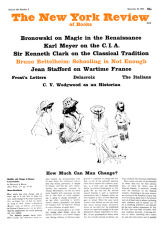During the last sixty years many young students of art history must have dreamt of writing a great book on the continuity of the classical tradition. It is an epic theme: the miraculous discovery in Greece, the long attenuation under the Roman Empire, the near destruction of the seventh century, the artificial respiration of Charlemagne, and the fascinating, unpredictable forms in which the tradition survived into the early middle ages. At this point the student’s ambition may have begun to flag, for the thought of carrying on from S. Trophime to the Farnesina, and then from Poussin and Bernini to Winckelmann and Canova, is altogether too daunting. So the student relinquishes his vast design, and explores one of the many delectable by-ways which branch off the main subject and often prove arduous and complicated enough to occupy him for a lifetime, as Fritz Saxl (to mention one of the greatest) was occupied by Zodiacal signs and calendars. For the subject as a whole is a killer, a minotaur which cost Aby Warburg his reason, and occupied thirty years of Berenson’s life with only the slenderest results. “Lovely and venerable monster what belt could encompass thee, what blade were long enough to pierce thy heart?”
Professor Rowland is no Theseus; nor is he quite a Parsifal. He sets out on his difficult quest with extraordinary naiveté, but without sufficient simplicity of purpose. The plan of his book (if it can be called a plan) is to polish off outstanding or typical episodes in the long history of the classical tradition in sixty-eight short chapters, arranged more or less chronologically. These chapters are often ludicrously short: for example the chapter entitled “Early Christian Art” is three pages long. They also show a deficient sense of proportion: the chapter on Nicola Pisano occupies two pages and two lines, whereas that on De Chirico occupies almost five. As is natural in an attempt to cover such an enormous field they also vary considerably in merit. A few contain good criticism: the Rheims Visitation, the Lanuvium head of Frederick II, Michelangelo’s Last Judgement, are all described with real insight. Professor Rowland’s notebooks must be full of useful observations, and the pity is that he has felt bound to pad them out with commonplace generalizations. Of course a book of this kind must be full of generalizations, and all generalizations are open to question. But one or two quotations will show that Professor Rowland’s generalizations are peculiarly vulnerable. Of Pisanello: “His art provides a transition from the particularized realism and formal splendor of the courtly style of the late middle ages to the more generalized ideation of forms typical of the Renaissance of the fifteenth century.” Of the early Quattrocento: “In such a world the old symbolical art which relied on the beauty of unreal, even abstract shapes, had no place…the study of nature, the investigation of the laws of perspective…provided a new and different discipline!” Surely anyone who had looked at Uccello’s battle pieces, or even at Piero della Francesca, would pause in astonishment at this statement, which is only a repetition of the most conventional nineteenth-century opinion. Statements of this kind are not only open to question; they are in many instances beside the point. The only hope for a book of this kind would have been to stick resolutely to the main theme, and not to have made it a potted history of western art. But unfortunately the author commits himself to some such course in his opening paragraph, when he says that the vicissitudes which accompanied the “momentous Hellenic choice constitutes in itself a history of western art and taste.” Only a man of great historic imagination, or of powerful philosophic mind, a Jacob Burckhardt or a Bertrand Russell, can treat such vast designs in such a way as to produce a readable and memorable book.
At this point one must ask for whom Professor Rowland’s book was intended. Not for scholars, that is evident; and not for the educated reader, who does not require conventional summaries of familiar information about the Pericleian age or the Renaissance. A sentence like this, which introduces the chapter on Donatello, would induce any intelligent adult to lay the book aside, “The greatest sixteenth-century biographer of Italian artists, Vasari, is an authority who commands our respect for his information on the great men of the fourteenth and fifteenth centuries.” (I must admit that this sentence has an early Victorian flatness which is almost endearing.)
The answer to my question seems to be that young people of school-leaving age are often glad of a broad, synthetic survey, like Bryce’s Holy Roman Empire, in which a long and complex period can be seen as a whole. The trouble is that students who have assimilated contemporary standards of value may be alienated by Professor Rowland’s painfully conventional opinions on almost every topic. A bright young mind likes to sharpen itself on difficulties, and prefers the obscurities of Reigl or Worringer to this sustained devotion to the obvious.
Advertisement
The author of an unfavorable review does well to pause at the end, and ask himself if he has in fact learnt anything from the book of which he has felt bound to write disparagingly. In this instance I cannot say that I have gained anything from the chapters on antique and mediaeval art; those on the early Christian and Byzantine periods are lamentable. But there are some good things in the Renaissance section. The comparison between Botticelli’s Birth of Venus and Masolino’s Baptism at Castiglion d’Olonna is new to me, and I am grateful. The chapters on neo-classicism are on the whole the best in the book and it seems a pity that Professor Rowland did not confine himself to that period, with which he is obviously in sympathy.
This Issue
September 10, 1964



